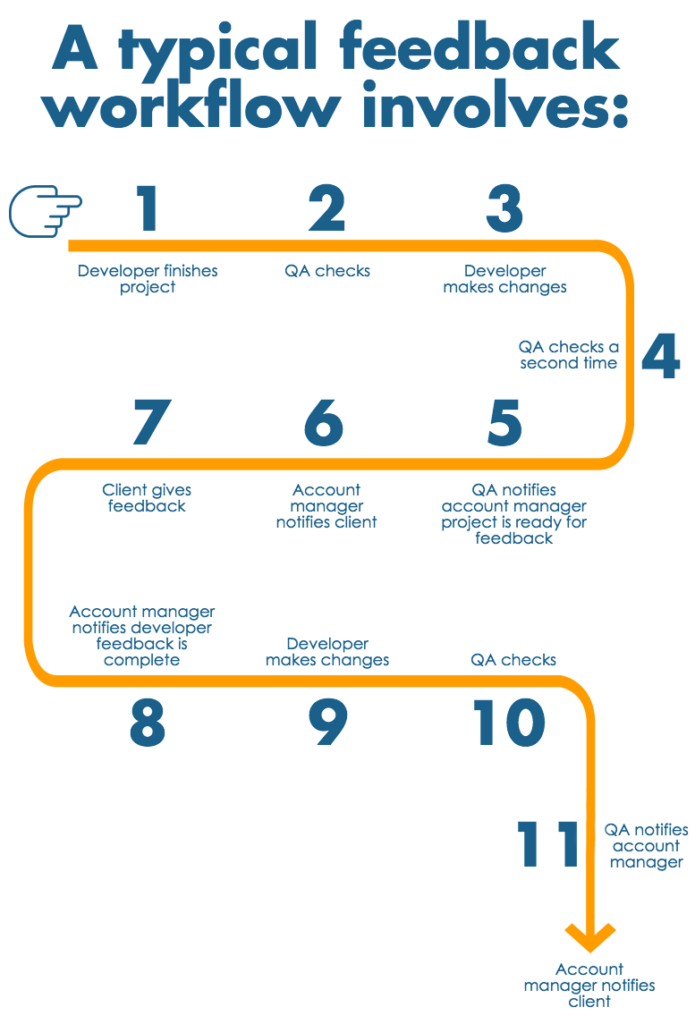Outsourcing WordPress Development: Fixing the Nightmare of the Feedback Process
In our three years, we have come across plenty of potential partners with bad experiences outsourcing WordPress development. Feedback processes are one of the key sticking points. A badly designed feedback process sucks time, produces a low-quality result, and diminishes trust between outsourcing partners. After getting burned a few times, it’s not surprising people come to think that remote development is not really all it’s cracked up to be.
It may seems odd that feedback processes are such an issue. After all, outsourcing a PSD to WordPress project would seem like it should be more straightforward than, say, outsourcing development of a fully-fledged smartphone app or desktop program. And in many ways, remote WordPress development is simpler. But what more complex development projects have are software and processes built specifically for them. Think: JIRA, the Agile methodology, Scrum, etc. These programs/systems have feedback processes built in. But since they are oriented towards incremental product development, they are not well suited to project manage one-off web development projects.
Instead, with WordPress development we have to invent our own processes. Many take an ad hoc approach, just using email or whatever chat client they happen to prefer to fire messages back and forth. But not thinking it through can lead to lots of small problems that add up. In a classic example of a sum that is greater than its parts, outsourcing a seemingly uncomplicated PSD to WordPress project might end up being more trouble than it’s worth. (Sneak peek: we’ve made a video explaining how to fix it. Scroll to the bottom to check it out.)
The Issues with Badly Designed Feedback
01 A bad feedback process means bad QA (hint: low quality)
Ideally, your outsourcing partner should have a great quality assurance process. In other words, you should hardly have to give any feedback. However, a poorly planned out feedback process for you, the client partner, is a strong hint that it’s disorganized internally, too. That means that there will likely end up being more mistakes for you to deal with in the first place.
02 Missing information leads to missed mistakes
Responsive design is one of the essential features of web development nowadays. If you and your developer are informally writing back and forth about bugs, s/he may not get key information about the context of the bug that is essential to solving the problem, like what browser or screen type you were using at the time.
03 One conversation stream buries relevant back-and-forth
Not infrequently, a requested change may require clarification or intermediate feedback from the client partner. For example, a developer may want to check that s/he understood the request precisely. If there are multiple brief exchanges like this, a vertical communication stream like email or chat makes it all to easy to miss a relevant question or response.
04 The workflow gets stuck
For a typical PSD to WordPress project, you likely only have one developer. However, if you are working with an outsourcing firm to do the WordPress development, you likely have at minimum an account manager and a quality assurance specialist also in the mix. A typical feedback workflow involves:

That’s a lot of passing the project around when it’s written out like that. Developers are probably on top of their role, since they primarily work on one project at a time. QA specialists and account managers, on the other hand, are juggling numerous projects at once in various stages of development. If they are processing everything through email or chat, projects can easily get delayed if they miss that a particular project has progressed to the next stage.
05 Lost in (visual) translation
If you’re looking at the website your WordPress developer has built, then writing down all of the necessary changes in the document, then your developer is reading those comments and taking them back to their graphical meaning in the website…then there are a lot of visual-to-text-to-visual translations happening here. The more such translations, the more possibilities for misunderstandings arise. Not to mention, going back and forth between graphical and verbal like this takes time.
Do the Math
It’s one of the most worn out cliches, but that doesn’t make it any less true: time is money. And for the reasons illustrated above, feedback can easily become a time-wasting, costly part of outsourcing WordPress development.
Our Chief Operation Officer Bobby King has worked to implement a system that optimizes the feedback process, both internally (for QA) and externally for partners. We integrate Trello directly with Usersnap, which facilitates feedback by direct annotation of website screenshots, which are then automatically generated as tasks in Trello. (Full disclosure: we haven’t been paid or asked to promote Usersnap or Trello, we just happen to think it’s pretty great at solving these problems.)
Bobby created a video explaining exactly how we use this process at The White Label Agency, and how it solves many of the problems that typically arise in the feedback process. Taking our own advice — it’s quicker and clearer to explain our visual feedback process visually than translating it into a whole lot of text here!
Here’s what he covers in the video:
0:00 Introduction
2:40 Setting up Trello for integration with Usersnap
2:57 Partner experience: opening Usersnap
3:38 How to give feedback in Usersnap
4:39 Developer experience: viewing and responding to feedback
5:30 Feedback workflow with Trello
Do you have any tips or tricks of your own for managing the feedback process with web development?



